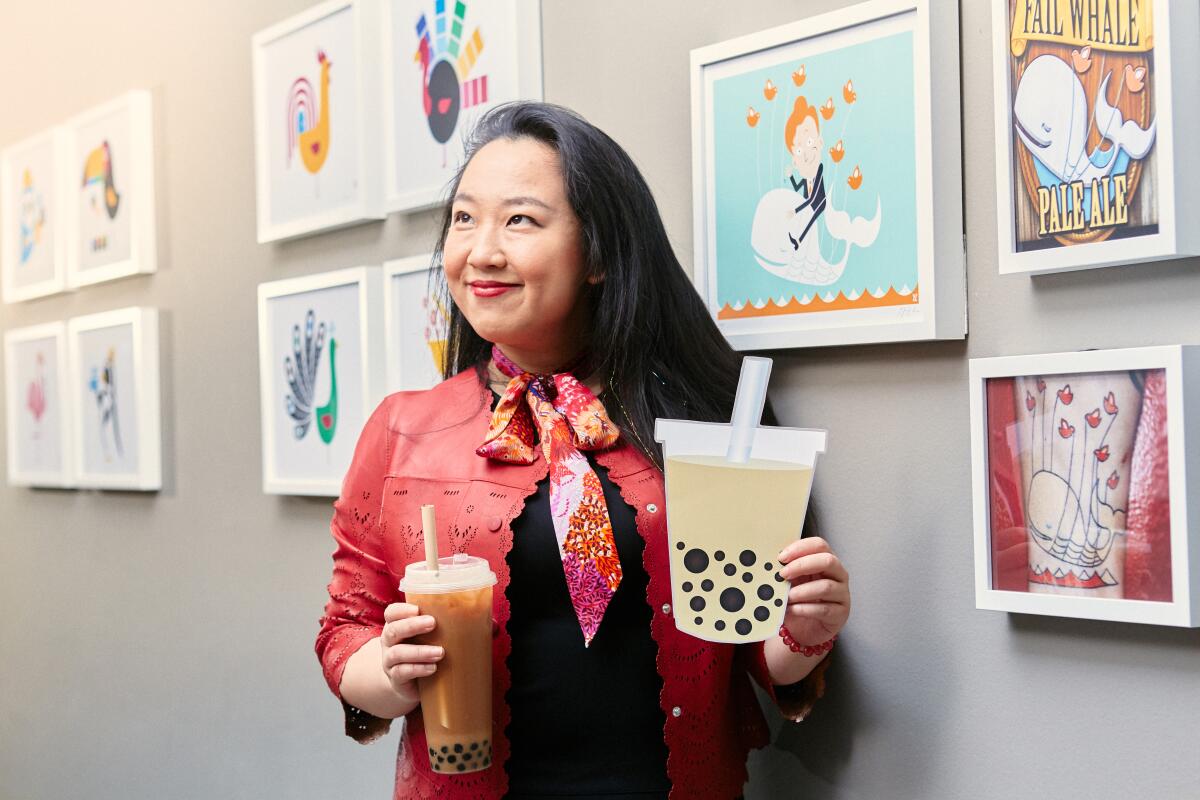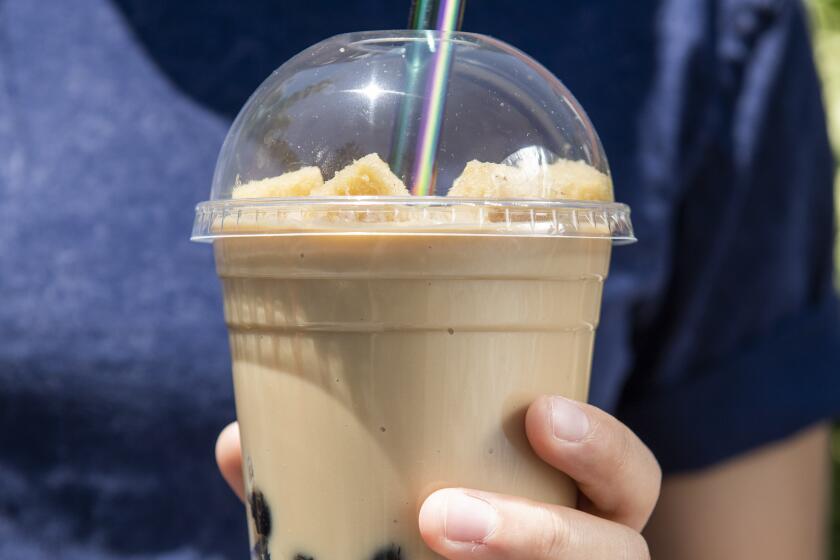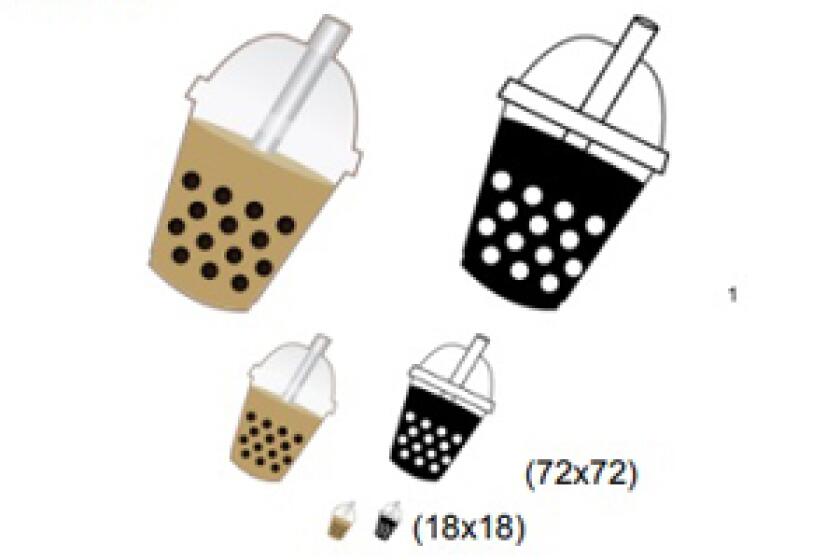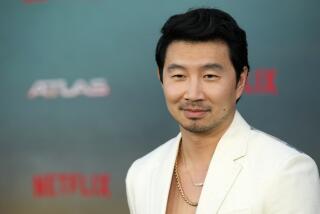A boba emoji is coming. Meet the woman who designed it
- Share via
“Boba is Cantonese slang for big boobs. Or a more literal translation could be dominatrix of breasts.”
On a recent afternoon, designer and creative director Yiying Lu sat in the corner of a downtown Los Angeles boba shop, sipping tapioca balls through a thick straw, cracking herself up as she talked through the origins of boba.
She was on a break from speaking at a creative festival at the convention center, still high from her talk on creating cross-cultural designs for a global audience and talking a mile a minute.
Her jet black hair was pulled back in a half ponytail and her lips painted fire engine red. Lu’s energy level hovers at an 11 out of 10, and she gestures with big exaggerated motions not often seen outside of Disney movies.
Lu is the reason you can send your significant other a dumpling emoji to suggest dinner plans or drop a takeout carton into your group chat to suggest Chinese food for tonight’s study group.

In the last five years, the 37-year-old has become the de facto digital designer of Asian-food-related emoji, including the new boba emoji, which should hit your smartphone keyboard when the next iOS update drops later this year.
Lu gained notoriety in the early 2000s for her creation of the Twitter “fail whale,” the image that once popped up when the social media app claimed to be over capacity.
“It was like I was being called,” she said in between gulps of milk tea. “It’s not that I want to design emojis, the emojis want me to design them.”
For Lu, creating emojis was part circumstance, part calling. It all started with an invite to a dumpling party in 2015. As a thank you, she designed a dumpling illustration to send to the host, Jennifer 8. Lee , and shared it in her workplace Slack instant messaging system. The dumpling made the rounds, quickly gaining fans around the 500 Startups office, where she was working at the time. She ended up framing a copy of the dumpling for her friend as a birthday present.
Shortly after, in need of a way to signal a boba break with colleagues, she created an image of a boba milk tea and dropped that into Slack.
The dumpling and boba emojis were so popular with Lu’s colleagues that she started to question why they weren’t actual emojis. After she and Lee did some digging, they discovered an organization called the Unicode Consortium, a group of retired engineers and other tech people that regulates and controls the emoji keyboard. After learning that anyone can submit an emoji for consideration, Lu decided to design and submit some key characters she believed our phones were missing: the dumpling, Chinese takeout box, chopsticks, fortune cookie and boba emoji.
“The community has a lot of people who were actually wanting to see these,” Lu said.
In December 2015, Lu designed most of the dumpling, chopsticks and boba emojis over weekends in San Francisco. She created the fortune cookie and takeout box while on a business trip through the Middle East, working on her designs while riding on a bus through Abu Dhabi. She submitted them to the consortium along with a proposal for each that covered the historical significance and cultural importance of the emoji characters.
After a few design tweaks they were all accepted, except for the boba emoji.
Kids are easy to please with homemade birthday cakes. This surprising boba birthday cake for teenagers can have the same effect.
Mark Davis, president and co-founder of the Unicode Consortium, declined to comment specifically on the boba emoji but said, “The factors for emoji selection include compatibility, expected usage level, image distinctness, completeness and how frequently requested the emoji is.”
Lu described her state of mind post-boba-rejection as simply “devastated.” She thought her chances of having a boba emoji had dwindled, until three boba aficionados from the University of Illinois at Urbana-Champaign and the University of California, San Diego reached out three years later.
One of them, Ranjitha Kumar, is an assistant professor in the computer science department at the Illinois school. At the time, she was part of a team that created a campus app that allows users to rate and review places exclusively using emojis.
“On the app, we noticed that whenever there wasn’t an emoji readily available, people would be very creative about sequencing existing emojis,” Kumar said. “Boba tea, it’s popular around campus, and people started using a tea emoji and milk emoji along with a black dot or circle.”
Lu, who was born and raised in Shanghai and moved to San Francisco after stints in Sydney and London, grew up drinking boba and spent many hours researching her design at boba shops around the Bay Area.
She first sketched out the emoji, drawing an upright cup filled with small black dots in no apparent pattern with a straight lid. After a few iterations, she ended up with a cup slanted at a 25-degree angle, boba in a set pattern against a light brown milk tea background and a domed lid with a straw.
Kumar and her colleagues Sujay Khandekar and Timothy Deng came across Lu’s rejected proposal after looking into submitting their own. They got in touch with Lu and together, they decided to resubmit the boba emoji to the consortium.
This time, Lu wasn’t taking any chances with the proposal. She did a deep dive into the history and etymology behind boba and extensively researched the origins of the drink. They submitted a comprehensive proposal that included graphics showing the increased prevalence of bubble tea as a search term on Google and expectations for its popularity in areas outside of Taiwan where it originated (even though boba has become ubiquitous in the San Gabriel Valley and Bay Area, in a lot of parts of the country, it’s still being discovered). The proposal included evidence documenting the likelihood of boba becoming a future trend like other drinks, such as sake.
“In Taiwan, it is more common for people to refer to bubble tea as pearl milk tea because originally, small ½-inch tapioca pearls were used,” Lu wrote in the proposal. “It was only when one tea shop owner, in an attempt to make his tea stand out, decided to use large tapioca balls and chose a more provocative name, ‘boba,’ to represent the difference.”
The proposal also cited various statistics, including Allied Market Research’s estimate that the bubble tea market, which was valued at nearly $2 billion in 2016, is expected to grow to more than $3 billion by 2023.
All the extra work paid off when the new boba emoji was approved last July.
Jocelyn and Justine Wong, a.k.a. the Hangry Diary sisters show us where to eat the best Taiwanese popcorn fried chicken and boba in the SGV.
“It’s something bigger than me,” Lu said. “It’s like, it’s a boba emoji, for God’s sake. But it’s also so much more.”
Those in the boba industry are also elated. Tommy Su of Bobalife USA, a Los Angeles-based boba tea import company that has a restaurant and tea shop in Monterey Park, says the new emoji could be great for business.
“We absolutely love that there’s finally a boba emoji,” Su said. He added that he had been looking into submitting a boba emoji himself before learning of Lu’s proposal. “Kudos to Yiying and her team for paving the way for boba and us Asian Americans to be further ingrained on the map.”
While Lu isn’t ready to reveal any other food or drink emojis in the works, she’s working on a phoenix emoji now.
“I happen to have this gift so I just have to manifest it into the world,” Lu said. “Manifesting more possibilities of beauty into the world. It’s why I do what I do.”
More to Read
Eat your way across L.A.
Get our weekly Tasting Notes newsletter for reviews, news and more.
You may occasionally receive promotional content from the Los Angeles Times.













